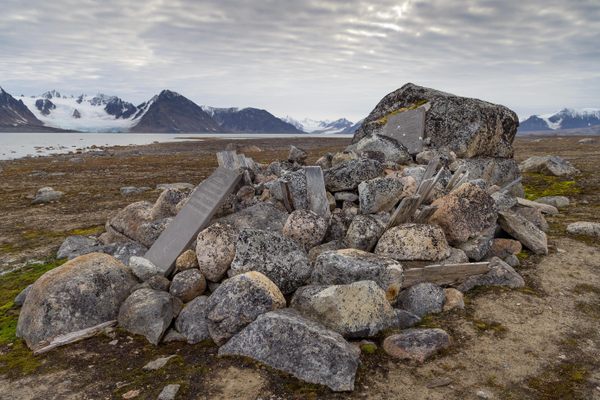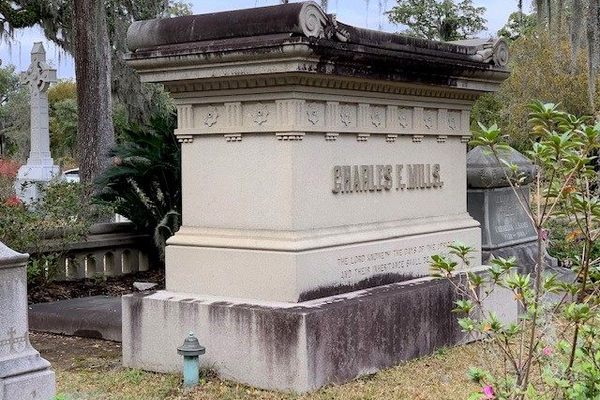Photographing Pet Cemeteries, A Dignified Death for Our Departed Pets
“Satan, We’ll Miss You,” at the pet cemetery in Calabasas, California (photograph by Paul Koudounaris)
If you measure a society by how it treats its dead, then much of the West right now is of the burying and leaving philosophy, putting the physical aspects of death at a distance. However, it’s a different case with animals, where the people who choose to memorialize their pets tend to engage deeply with mortality, a much quicker cycle for our furry, scaly, and feathery companions.
Paul Koudounaris has taken extraordinary photographs of the human dead, with ossuaries and charnel houses in The Empire of Death and bejeweled religious relics in Heavenly Bodies. Now for the first time the California-based photographer and author is focusing on the death of animals, and how humans remember them. Koudounaris traveled to Thailand, Taiwan, Germany, Finland, Sweden, the UK, and around the United States, wandering pet cemeteries and other spaces of memory. He answered a few of our questions about the rites of dead cats and dogs.
Cimetière des Chiens, Paris (photograph by Paul Koudounaris)

Your previous work — Empire of Death and Heavenly Bodies — has been very much about the venerations of human dead. Why the interest in pets?
Mourning of pets is, to use a modern phrase, “under represented.” We pay a lot of attention culturally to human dead and the way they are remembered and memorialized. Studying aspects of (human) death has become not only popular lately, but one might even say trendy. But not so with animal dead, even though companion animals are just as much an intimate part of our lives as any friend or family member.
There is, culturally, a discrimination against animal dead, because they are “only” animals. For instance, if a relative dies, the outpouring of empathy is such that your job would most certainly give you time off, and probably a lot. If your dog or cat died, I don’t know, in an extremely sympathetic situation maybe they would give you a day off. But in reality I have talked to more people than I can count who have told me that the loss of their pet was more painful and harder to reconcile than the death of any of their relatives had been.
Well, there are a lot of things which appeal to me about the topic of animal mortality, among them different theological approaches to dealing with the animal afterlife and the issue of whether their souls are equivalent to those of humans. But mostly it is this dichotomy between the way we treat, mourn, and respect human vs. animal dead that initially interested me. It also provided a way to move forward. I have two books dealing with the human dead and have third in the can (it will be out in spring of next year), so after three books and a lot of years, I wanted to move on to something else, and I decided to start taking a look at what I perceived a double standard when it came to dealing with animal mortality.
Animal columbarium with Buddhist altar in Taiwan (photograph by Paul Koudounaris)
You’ve mentioned that places involving animal mortality have a different sort of interest than humans. Do you have any examples of how you’ve encountered this?
Places focused on animal mortality tend to be much more raw and direct in their expressive quality than places that deal with human mortality. In our culture, mourning has been refined through a series of rituals and symbolic gestures designed to sublimate grief. You know, all this Victorian memento mori stuff that people are so in love with, and the tomb sculptures, and the poems, are all wonderful, but they are also a rhetorical language which masks the raw power of emotion. But pet cemeteries and pet memorials are different.
When I first started hanging around in them, I kept thinking of Jean Dubuffet, because I realized, this is kind of the Art Brut of mourning. There are no canonical or accepted means of expressing the loss of a companion animal in our culture, so people are left to their own devices to come up with what they think is suitable, and the result is a much more direct language of grief, without convention to fall back on.
The first time I went to photograph a pet cemetery, to really give it the full effort, was back in December, when the layouts for my forthcoming book were so delayed that I was chomping at the bit looking for something to work on. I decided, well, I’ll go down to the pet cemetery in Gardena (a suburb of Los Angeles) and see what I can come up with if I try to do a photo study of the place. Now, I have been to every monument to human mortality you can think of — if you know my books, and especially when you see the forthcoming one, you’ll know that I have seen as much death and mourning as the world has to offer. And I’m completely callous to it by now — or so I thought.
I spent about six hours in that pet cemetery, photographing. Looking at what people had left and written, to try to express the bond they had with these speechless, innocent creatures, to try say their goodbyes. At one point drops of water started to hit the camera. Oh crap, it’s raining I thought. And then I looked up, not a cloud in the sky. And I realized — no, it’s not raining, it’s me, Jesus, I’m crying — it got to me. All those monuments to human mortality could not shield me from six hours with these cats and hamsters, they got to me, they broke me in a way that no human cemetery ever had. As I said, because the grief is not conventionalized, and it can be so raw. That experience really got me hooked, because I realized if it had that power over me, what power could it have on other people?
Tierfriedhof in Stuttgard, Germany (photograph by Paul Koudounaris)
What is the state of pet mourning like now?
I don’t know that I can speak overall to the state of pet mourning, but one thing I can do is compare it here to what I have seen in other cultures. I was recently studying this in Thailand. There are four temples in Bangkok that have crematoria for animals and provide animal funerals. I went down and spoke to the monks at one, explained who I am and what my interest was, and they invited me to come back the next morning and participate in a funeral for a dog and photograph it.
Dog surrounded by flowers before its funeral in Bangkok, Thailand (photograph by Paul Koudounaris)
It was a profound experience, and one with a sense of completeness and closure that we simply lack when it comes to mourning departed animals in American and European culture. I brought the dog in with the owner, it was placed in a box. A monk came and connected us all to the dog’s body with a string, and then he led several prayers. We then took the dog, surrounded him in flowers, and we placed him ourselves in the crematorium and offered him to the flames. When he had burned, the ashes were placed in an urn, which we then topped with flower petals.
Everyone kissed the dog’s remains, and they were then wrapped into a cloth package and we all went together on a boat down river. The owner said her final goodbyes and kissed the package and let it float away, and we sprinkled the flower petals over the water. The monks told me they do between four and ten of those ceremonies a day. So what is the state of pet mourning like now? I guess it depends on where you are — if you are in that temple, it’s a whole lot more sophisticated and empathic that if you are in the USA. But remember, when we talk about Buddhists, they have never denied souls to animals, so in that culture they are deserving of the same kind of respect and ritual as a human being.
Memorial for “Judy” in Rossendale, UK (photograph by Paul Koudounaris)
Hyde Park pet cemetery (photograph by Paul Koudounaris)
Pet cemetery in Djurgarnden, Stockholm, Sweden (photograph by Paul Koudounaris)
Pet cemetery in Calabasas, California (photograph by Paul Koudounaris)
Abandoned pet cemetery in Molesworth, UK (photograph by Paul Koudounaris)
Find more on our monuments to mortality by Paul Koudounaris at Empire de la Mort.
Continue your exploration of how we remember our dead pets on Atlas Obscura, with our visit to the Paris Cemetery of the Dogs, Hartsdale Pet Cemetery in New York, and more pet cemeteries around the world.















Follow us on Twitter to get the latest on the world's hidden wonders.
Like us on Facebook to get the latest on the world's hidden wonders.
Follow us on Twitter Like us on Facebook